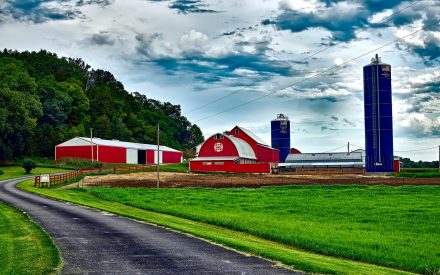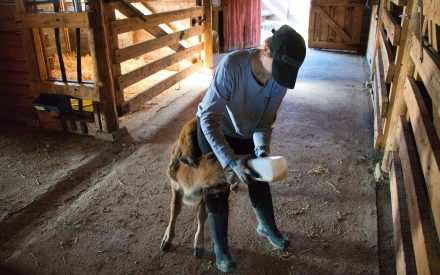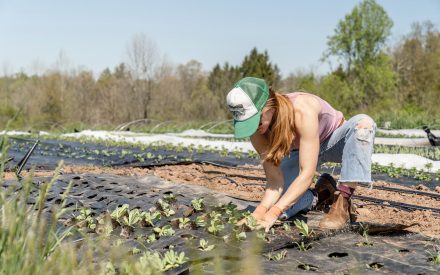Article Series
Farm Management Friday video: “Is Fair Equal?“
A common misconception in farm estate and succession planning is that federal estate taxes are among the biggest threats to getting the farm assets to the rightful heirs. The Federal estate tax has been around since 1916 and is applied to property transferred at death. Legislation over the past 20 years has considerably eased the estate tax burden. The most recent legislation to address estate tax policy is the Tax Cuts and Jobs Act (TCJA) of 2017. The TCJA exemption amount is indexed for inflation, and in 2021 it allows an estate up to $11.7 million per individual ($23.4 million for married couples)1. However, the exemption amount outlined in the TCJA is temporary and will return to $5 million per individual on Jan. 1, 2026, if there are no legislative changes before that date. The 2026 exemption amount is still subject to an inflation index.
Under present law, the estate of a deceased individual owning assets above the exemption amount must file a Federal estate tax return. While many farm asset values may require filing a Federal estate tax return, it is essential to remember that debts against the assets will bring down the final estate value. Filing the Federal tax return does not guarantee that the estate will have to pay estate taxes.
To illustrate how few farms are affected by estate taxes, the USDA Economic Research Service estimated that in 2018 – 38,106 farm estates would be created. Of those farm estates, 0.6% (or 230 estates) would need to file a Federal estate tax return, and only 0.35% (or 133 estates) would have to pay an estate tax2. Therefore, we propose that the biggest threat to a farm estate getting to the rightful heirs is the owner generation’s lack of succession planning and not federal estate taxes.
Farm Assets as Three Buckets
Many farm families need their farm assets to fill three buckets: business assets, retirement assets, and inheritance assets. It is common for farmers to reinvest a majority of profits back into the farm business. They are building capacity, maintaining, or modernizing buildings or making the business attractive to the next generation. They may be expanding the size of the operation to capitalize on economies of scale. If farmers invest too heavily in the farm business and do not contribute enough to other non-farm retirement assets the farm business assets may need to supply retirement income. If a successor is already working in the business, the successor may assume there is a plan to make business assets accessible and affordable as they take over the farm. If there are off-farm heirs, the owners may also want the farm assets to serve as inheritance assets. In some cases, the successor generation needs to help service the owner generation’s debt on the inheritance assets. If the farm assets are needed to fill the retirement and business buckets, is it financially feasible for the farm assets to also fill the inheritance bucket? Careful and early succession planning and honest communication is required to determine the farm’s capacity to fill the three buckets.
Inheritance: Property transfer or emotional symbolism?
Inheritance is the transfer of private property, titles, privileges, rights, debts, and other obligations upon an individual’s death3. Property inheritance is most common within families. Traditionally, when we speak of inheritance of farm assets, we are referring to land, machinery, livestock and feed and crop inventories. Untitled property such as heirlooms, antiques, or memorabilia that may have monetary or sentimental value should also be considered an inheritance asset. The transfer of property can have a symbolic significance within a family’s culture. It might symbolize trust, love, power, family rituals, or history.
Considering the symbolism associated with inherited assets, these decisions can be a daunting task for the owner generation. To spare themselves the emotional aspect of succession planning, many farm owners do not create a plan, and thereby their estate is subject to the state’s succession plan. The state’s plan is to divide the assets equally among the heirs. Some farm owners choose to create a succession plan that distributes farm assets equally to their heirs, identical to the state succession plan. Equal distribution of the farm assets can increase the likelihood the farm assets will not be available for the on-farm successor.
The farm business’s growth is impeded when the successor must purchase the farm assets from the owner generation or their siblings, at or near full market value. The practice of purchasing the farm assets at full market value puts the business at risk of failing every time it is transitioned. Many farms do not generate the cash flow necessary for the successor to purchase the farm assets outright at full market value. Keep in mind that the farm operation has had to generate sufficient income and profits to initially acquire these assets at or near full fair market value. Should the farm or the successor generation have to pay to acquire them at full fair market value again, the farm essentially is being asked to pay for its assets twice, a staggering challenge for a farm operation.
Oklahoma State University has created a statistical model that compares various transition strategies and their probabilities of success. The results demonstrate that the most common farm succession strategy of dividing the assets equally among all heirs has the lowest success rate. Farms employing this strategy normally do not continue to the next generation4.
The owner generation often elects to divide the assets equally because they want to treat all of their children equally and not choose favorites. They hope their children will “do the right thing” and sort out the assets to fit their needs. The extent to which this strategy succeeds depends on the sibling’s relationship and their definitions of fairness aligning. Research indicates that higher levels of conflict are predicted when sibling relationships have not been close in the past and siblings have different rules of fairness5. Childhood rivalries may reignite when parents are no longer there to smooth over relationships. The impacts of grief can compound these flare-ups.
While it may be too late to improve distant sibling relationships, the owner generation may be able to discuss and implement fairness “rules” that can help their children better understand the parents’ distribution of assets. Keep in mind as we talk about these theories, we are focusing on the business assets. There may be off-farm assets, such as a vacation home, recreational property, or off-farm investments that parents may want to treat differently than business assets. Two theories are used to understand the inheritance decision-making process:
- Distributive Justice is concerned with the distribution of property, and the fairness of that distribution
- Procedural Justice is concerned with the process used to distribute property and the perceived fairness of the distribution
The distributive justice approach to inheritance distribution requires the owner generation to choose how they want to distribute their inheritance. When deciding, the owner may consider three basic principles6:
- Equality principle: assets are divided equally among heirs regardless of their contributions
- Proportional equity principle: distributions of assets are in proportion to the heir’s contribution in maintaining or growing the asset
- Needs-based principle: the heirs’ needs are given primary consideration
In reality, farm families may make decisions based on all three principles. The owner generation may intend to use the proportional equity principle once an on-farm heir has been identified and has started contributing to the farm as an adult. However, if an adult child is in need, it could be difficult for a parent to refuse a request because that heir has not contributed to the farm. As the owner generation ages, they may be influenced to make the division equal in hopes of maintaining their relationship with their children. In doing so, they do not consider the damage this does to the business’s financial position and future sibling relationships.
Procedural Justice Theory has seven elements of procedural fairness for which rules are created7. Heirs can then evaluate these procedural elements to assess the procedure’s overall fairness. These procedural elements include:
- Ground rules for determining potential rewards and behaviors to attain them
- Defining the decision structure, such as order, timing, and methods of arriving at the final decision
- Selection of agents, or who makes the allocation decisions and the persons involved
- Safeguards to ensure against abuse of power for the following rules
- Information gathering and obtaining procedures
- Procedures for appealing unsatisfactory decisions
- Change mechanisms to alter processes when outcomes are unfair
If Procedural Justice Theory is chosen, it is essential to follow the structure or carefully explain why the facts have changed to warrant adjusting the structure of inheritance.
Regardless of how an owner decides to split farm assets, the owner generation needs to be honest with themselves and their heirs regarding the farm’s actual financial capacity to finance the family and business’s goals. If the goals prioritize keeping the business in place for the next generation, then an equal distribution of farm assets is not feasible. The owner generation must take responsibility for communicating the goals and justify an unequal distribution. Communication among family members that leads to clear goals and expectations before the passing of the owner generation is vital for a smooth transition. The more the off-farm heir understands about the decision-making process, the easier it is for them to see the fairness of that decision. While the owner generation may feel that they do not need to explain their decisions, doing so can help with sibling harmony after they have passed. Regularly scheduled family meetings that allow for precise and honest communication about the farm business and tensions around estate planning create an environment where each family member can feel valued and heard. These family meetings help clarify each person’s status in the farm business, whether they are on-farm or off-farm8.
Reviewed by:
John Baker, Staff Attorney for the Iowa Concern Hotline, Iowa State University
Bridget Finke, Attorney and Partner of Valley Crossing Law, Baldwin, Wisconsin
References
- https://www.whww.com/legal-articles/estate-tax-landscape-for-2021-and-beyond/#:~:text=Under%20the%20TCJA%2C%20the%20current,and%20%2411.7%20million%20for%202021.
- https://www.ers.usda.gov/topics/farm-economy/federal-tax-issues/federal-estate-taxes/
- https://en.wikipedia.org/wiki/Inheritance
- Reed, Garret, J. 2017. Assessing The Rate of Success of Alternative Farm Transition Strategies. Oklahoma State University. Master’s Thesis
- Taylor, J.E., and Norris, J.E., (2000). Sibling Relationships, Fairness and Conflict over Transfer of the Farm. Family Relations,49, No. 3, pp. 277-283.
- Olsen, C. S., and Osborn, T. (2006). “Inheritance: “A Tale of Two Perceptions,” Online Journal of Rural Research & Policy: 1: Iss. 5. http://dx.doi.org/10.4148/ojrrp.v1i5.33
- Levanthal, G.S., Karuza Jr., J., & Fry, W.R. “Beyond fairness: A theory of allocation preferences,” in G. Mikula (Ed.), Justice and Social Interaction (pp.167-218), New York: Springer-Verlag (1980).
- Jaffe, D. Working with the ones you love. Berkeley, CA: Conari Press (1990).

 Common strategies to consider for Fair vs Equal
Common strategies to consider for Fair vs Equal Farm asset division a 21st-century conundrum
Farm asset division a 21st-century conundrum Sweat equity and farming
Sweat equity and farming What are the Tax Implications of Sweat Equity Arrangements on Wisconsin Farms?
What are the Tax Implications of Sweat Equity Arrangements on Wisconsin Farms?


